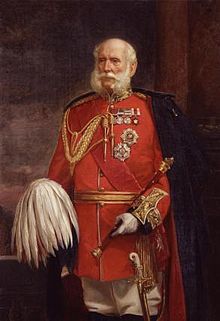| 104th Regiment of Foot | |
|---|---|
| Active | 1765–1803 1822–1830 1839–1881 |
| Country | |
| Branch | |
| Type | Infantry |
| Size | One battalion |
| Garrison/HQ | Ballymullen Barracks, Tralee |
| Engagements | First Rohilla War Second Anglo-Sikh War Second Anglo-Burmese War Indian Rebellion |
The 104th Regiment of Foot was a regiment of the British Army, raised by the Honourable East India Company in 1765. Under the Childers Reforms it amalgamated with the 101st Regiment of Foot (Royal Bengal Fusiliers) to form the Royal Munster Fusiliers.
History

Early history
The regiment as first raised by the Honourable East India Company as the 2nd Bengal European Regiment when it was formed from the 1st Bengal European Regiment in 1765. It went to take part in an action at Rohilkhand in April 1774 during the First Rohilla War before being absorbed by the Marine Battalion in 1803. It was re-raised as the 2nd Bengal (European) Regiment in 1822 and took part in a deployment to Burma in 1825 before being disbanded in 1830.
The Victorian era

The regiment was re-raised as the 2nd Bengal (European) Light Infantry from a nucleus of 1st Bengal (European) Regiment in 1839. It saw action at the Battle of Chillianwala in January 1849 and the Battle of Gujrat in February 1849 in the Punjab during the Second Anglo-Sikh War. The regiment became the 2nd Bengal (European) Fusiliers in 1850 was deployed to Burma again in 1853 during the Second Anglo-Burmese War and then served at the Siege of Delhi in autumn 1857 during the Indian Rebellion. After the Crown took control of the Presidency armies in the aftermath of the Indian Rebellion, the regiment became the 2nd Bengal Fusiliers in November 1859 and then the 1st Royal Bengal Fusiliers in May 1861. It was then renumbered as the 104th Regiment of Foot (Royal Bengal Fusiliers) on transfer to the British Army in September 1862. Although a new commanding officer was appointed on transfer to the British Army, both majors and six of the twelve captains had prior service in the regiment.
During the cholera epidemic of 1869, the regiment left its barracks at Peshawar on the North West Frontier for the countryside, to try to alleviate the impact of the disease. After the regiment had returned to barracks with the end of the epidemic, the commanding officer's wife, Elizabeth Webber Harris, was presented with a gold replica Victoria Cross, by the officers of the regiment, for her tireless endeavours tending the sick men. The presentation had the approval of Queen Victoria and was made by General Sir Sam Browne, commander of the Peshawar garrison. The regiment embarked for England in 1871.
As part of the Cardwell Reforms of the 1870s, where single-battalion regiments were linked together to share a single depot and recruiting district in the United Kingdom, the 104th was linked with the 101st Regiment of Foot (Royal Bengal Fusiliers), and assigned to district no. 70 at Ballymullen Barracks in Tralee. On 1 July 1881 the Childers Reforms came into effect and the regiment amalgamated with the 101st Regiment of Foot (Royal Bengal Fusiliers) to form the Royal Munster Fusiliers.
Battle honours
Battle honours won by the regiment were:
- Rohilla War: Rohilcund 1774 (inherited from predecessor regiment)
- Second Anglo-Sikh War: Chillianwallah, Goojerat, Punjaub
- Indian Mutiny: Delhi 1857
Regimental Colonels
Colonels of the Regiment were:
- 2nd Bengal Fusiliers (HEIC)
- c.1859: Maj-Gen. Robert Blackall
- 104th Regiment of Foot (Bengal Fusiliers) (British Army)
- 1862–1863: F.M. Sir Patrick Grant, GCB, GCMG
- 1863–1867: Gen. Sir George Bell, KCB
- 1867–1874: Gen. George Dixon
- 1874–1881: F.M. Sir Frederick Paul Haines, GCB, GCSI, CIE
References
- ^ "104th Regiment of Foot (Bengal Fusiliers)". regiments.org. Archived from the original on 10 February 2006. Retrieved 4 September 2016.
{{cite web}}: CS1 maint: bot: original URL status unknown (link) - ^ "104th Regiment of Foot (Bengal Fusiliers): Locations". Regiments.org. Archived from the original on 10 March 2006. Retrieved 31 March 2017.
- "No. 22667". The London Gazette. 30 September 1862. p. 4681.
- Ashcroft, Lord (18 March 2015). "Only woman to win a Victoria Cross: Elizabeth Webber Harris saved soldiers with cholera". Express.co.uk. Archived from the original on 7 April 2018. Retrieved 7 April 2018.
- "Training Depots". Regiments.org. Archived from the original on 10 February 2006. Retrieved 16 October 2016.
Further reading
- Innes, Lieutenant-Colonel P. R. (1885). History of the Royal European Regiment, now the Royal Munster Fusiliers. London: Simpkin.
External links
- Mills, T.F. "104th Regiment of Foot (Bengal Light Infantry)". regiments.org. Archived from the original on 22 October 2007. Retrieved 15 October 2007.